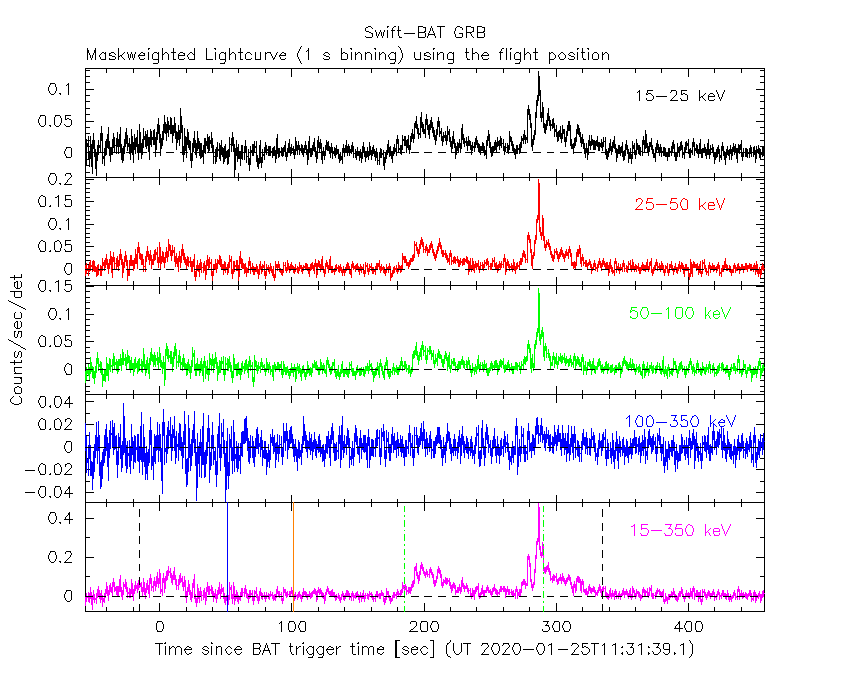
A.Y. Lien (GSFC/UMBC), A. Tohuvavohu (U. Toronto) and K.K. Simpson (PSU) for the Swift team
At 11:31:39 UT, the Swift Burst Alert Telescope (BAT) triggered and located GRB 200125A (trigger=952164) (Lien et al. GCN Circ. 26876). Swift slewed immediately to the burst. At the time of the trigger, the initial BAT position was 77° from the Sun (5.3 hours West) and 84° from the 0%-illuminated Moon. Table 1 contains the best reported positions from Swift, and the latest XRT position can be viewed at http://www.swift.ac.uk/xrt_positions.
Melandri et al. (GCN Circ. 26887) reported the position from TNG for the optical afterglow of this GRB. Table 2 is a summary of GCN Circulars about this GRB from observatories other than Swift.
Standard analysis products for this burst are available at https://gcn.gsfc.nasa.gov/swift_gnd_ana.html.
As reported by Markwardt et al. (GCN Circ. 26897),
the BAT ground-calculated position is RA, Dec = 228.069, -8.142 deg which is RA(J2000) = 1
The mask-weighted light curve (Figure 1) shows a multi-pulse structure that starts at ~T-40 s and ends at ~T+430 s.
The three main pulses occurs at ~
The time-averaged spectrum from T-36.22 to T+427.74 s is best fit by a simple power-law model.
The power law index of the time-averaged spectrum is 1.95 ± 0.08.
The fluence in the 15-150 keV band is 8.7 ± 0.4 x 1
The results of the batgrbproduct analysis are available at https://gcn.gsfc.nasa.gov/notices_s/952164/BA/.
Analysis of the initial XRT data was reported by Tohuvavohu et al. (GCN Circ. 26884). We have analysed 16 ks of XRT data for GRB 200125A, from 127 s to 383.9 ks after the BAT trigger. The data comprise 286 s in Windowed Timing (WT) mode with the remainder in Photon Counting (PC) mode. The enhanced XRT position for this burst was given by Beardmore et al. (GCN Circ. 26878).
The late-time light curve (Figure 2) (from T0+3.8 ks) can be modelled with an initial rise, with a power-law index of α=-0.71 (+0.19, -0.23), followed by a break at T+15.8 ks to an α of 0.84 ± 0.07.
A spectrum formed from the WT mode data can be fitted with an absorbed power-law with a photon spectral index of 1.523 ± 0.029. The best-fitting absorption column is 3.05 (+0.17, -0.16) x 1
A summary of the PC-mode spectrum is thus:
Total column: 1.3 (+0.5, -0.4) x 1
Galactic foreground: 7.7 x 1
Excess significance: 2.0 σ
Photon index: 2.17 (+0.19, -0.18)
The results of the XRT team automatic analysis are available at http://www.swift.ac.uk/xrt_products/00952164.
The Swift/UVOT began settled observations of the field of GRB 200125A 179 s after the BAT trigger
(Simpson and Lien GCN Circ. 26892).
No optical afterglow consistent with the XRT position (Beardmore et al. GCN Circ. 26878) is detected in the initial UVOT exposures.
Table 3 gives preliminary
magnitudes using the UVOT photometric system
(Breeveld et al. 2011, AIP Conf. Proc., 1358, 373).
No correction has been made for the expected extinction in the Milky Way
corresponding to a reddening of

Figure 1. The BAT
mask-weighted light curve in the four individual and total
energy bands. The units are counts

Figure 2. The XRT light curve.
Any data from a crosshatched region are not included in the fit.
| RA (J2000) | Dec (J2000) | Error | Note | Reference |
|---|---|---|---|---|
| 1 |
-08°08'38.9" | 1.5" | XRT-final | UKSSDC |
| 1 |
-08°08'40.3" | 2.5" | XRT-enhanced | Beardmore et al. GCN Circ. 26878 |
| 1 |
-08°08'31.3" | 1.8' | BAT-refined | Markwardt et al. GCN Circ. 26897 |
| Band | Authors | GCN Circ. | Subject | Observatory | Notes |
|---|---|---|---|---|---|
| Optical | Lipunov et al. | 26881 | Swift GRB 200125A: Global MASTER-Net observations report |
MASTER | |
| Optical | Watson et al. | 26882 | RATIR Optical Observations | RATIR | |
| Optical | Liu et al. | 26883 | Nanshan-0.6m optical upper limit | Xinjiang Astro. Obs. | upper limits |
| Optical | Melandri et al. | 26887 | TNG detection of a NIR counterpart candidate |
TNG | detection |
| Optical | Belkin et al. | 26889 | AbAO optical upper limit | Abastumani Astro. Obs. | upper limits |
| Optical | Watson et al. | 26891 | Further RATIR Optical Observations and Confirmation of Fading |
RATIR | detection |
| Gamma-ray | Ridnaia et al. | 26935 | Konus-Wind observation | Konus-Wind | Fluence=2.04(-0.16,+0.22)x1 |
| Filter | Exp(s) | Mag | ||
|---|---|---|---|---|
| whit |
179 | 329 | 147 | >20.4 |
| white | 179 | 4176 | 344 | >21.1 |
| v | 4387 | 4586 | 197 | >18.4 |
| b | 3771 | 3971 | 197 | >19.9 |
| u | 337 | 414 | 75 | >18.9 |
| w1 | 4796 | 4835 | 38 | >18.6 |
| m2 | 4591 | 4791 | 197 | >19.3 |
| w2 | 4182 | 4382 | 197 | >20.2 |
Table 3. UVOT observations reported by Simpson and Lien (GCN Circ. 26892). The start and stop times of the exposures are given in seconds since the BAT trigger. The preliminary 3-σ upper limits are given. No correction has been made for extinction in the Milky Way.
January 30, 2020